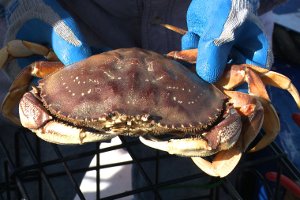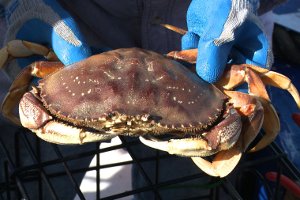On opening day last week (following a shark tagging trip), I joined my colleagues of Team Fish Finder on the Tiburon and helped pull traps off Baker Beach. In truth, having an interest to make a documentary on local fisheries, I malingered and filmed the whole affair. Steve and his crew hauled several more traps, some disappointing, and others containing several legal sized crabs. Fishing seasons are built around the “3 S’s”: size, sex and season. The males with shells over 6.25 inches in width went into the cooler as the smalls, fresh molts and all females went back into the water. We also pulled in the smaller rock crabs that Steve returned to the water. The traps - or pots as they are called - are composed of wire mesh, equipped with an odorous mixture of fish guts and heads and two doors sized to allow big crabs in I but small crabs out. With an average haul, we steamed back beneath the Golden Gate Bridge, joining a fleet of small boats heading home with the first season’s crabs.
Crabs are based not only on size but also the fullness or fat content. The test crabs are looking a little thin so the California Fish and Game delayed opening the commercial season for the Central Coast region until today. While we are thinking of fresh cracked crab or a Crab Louie, the commercial fisherman depending on a good haul for most of their annual income are likely wondering, "Will it be good year?"
It’s a cyclical fishery and important economically. In the last ten years, San Francisco’s open-ocean crab catch has varied from a high of six million pounds in 2009-2008 to a 10-year low of 1.1 million in 1999-2000.
The 1.1 million tons of Dungeness crab harvested off the coast of San Francisco was less than one-third of the average annual local catch recorded over the past decade, Department of Fish and Game figures show. However, last year’s catch rebounded to 14.7 million tons worth 33 million dollars. With the salmon closure and the crash of the herring population crab season has grown increasingly important for Bay Area fishermen.
It’s the Pots. Out-of Town Fishermen Impacting Local Fishery
There are more complicated issues than seasonal variability affecting the local fishery. Aside from the Cosco Busan disaster seriously impacting the fishery in 2007, there are regulatory and market forces at work. The Central California crab season opens two weeks earlier than in Oregon and Washington State and both those states have large commercial crab fishing vessels who can set hundreds of traps at a set.
These larger vessels steam down and fish the season opener in the Bay (typically the best haul of crabs), and return with full holds to fish their own opener. While some sell locally and lower the price by saturating the market, still others are fishing heavily and offloading in the northern ports.
Unlike Washington and Oregon, California has no limits on the number of traps or pots that each boat can set, meaning that the large boats can catch huge amounts of crab in just a few days. The best quality crab is a live crab. The crabs caught in the large vessels sit in a hold and are off loaded damaged, dead and dying. Where our local industry is small and family owned, fishing each day and providing fresh crab to local buyers, the large boats can stay out for days in rough weather and get 30,000 to 50,000 pounds per trip. Much of this crab is exported and canned.
Besides the increased pressure on the crab population, there are other problems introduced by the increased number of pots. The opener has the best catch, creating a race to fish. This forces the smaller boats to put themselves at greater risk in an already dangerous fishery. Also, despite built-in design for small crabs or other animals to escape, pots break loose in storms becoming “ghost traps” which keep fishing and killing crabs without potential to recover. Mariners also are concerned that the large numbers of pots are a navigation hazard.
The Dungeness Crab Task Force: Legislation to Limit Crab Pots
Local crabbers would like to see a limit on traps set. In recent years two bills have been passed to limit the number of traps but were vetoed by the Governor. Currently, there is new hope that a solution may be coming. State Senator Pat Wiggins (Second District representing North Bay to Eureka) has authored legislation (SB1690) establishing a Dungeness Crab Task Force. Composed of crabbers and crab processors from around California, the task force has made several recommendations including limiting pot limits, pot design and other measures to help local fishermen. The task force proposed additional amendments to the pending legislation which will impact pot limit proposals. Until this legislation works its way through committees and is signed by the governor these limits will not be in effect.
With the loss of salmon, rock cod, halibut and tuna, our local fleet depend on a healthy crab fishery to maintain their livelihood and the fishing heritage of San Francisco. Until limitations are applied, our local crabbers will be setting pots alongside the larger out-of-state vessels.
Until the legislation makes its way through committees, we can support our local fishermen by buying fresh local crab in season only from local boats or from local fishmongers who purchase directly from San Francisco Bay fishermen. Like all seafood choices, we should avoid buying unsustainable seafood from large warehouse chains (starts with a C- ends with an o) and question where our fish comes from and how it was caught.
 Got Crabs? It's opening day for San Francisco’s favorite crustacean: the Dungeness crab.
Got Crabs? It's opening day for San Francisco’s favorite crustacean: the Dungeness crab.